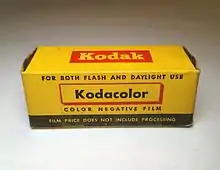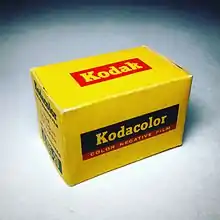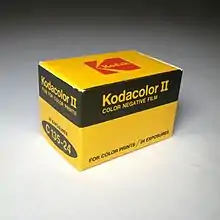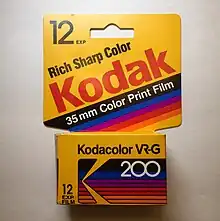Kodacolor (still photography)
In still photography, Kodak's Kodacolor brand has been associated with various color negative films (i.e., films that produce negatives for making color prints on paper) since 1942. Kodak claims that Kodacolor was "the world's first true color negative film".[1] More accurately, it was the first color negative film intended for making paper prints: in 1939, Agfa had introduced a 35 mm Agfacolor negative film for use by the German motion picture industry, in which the negative was used only for making positive projection prints on 35 mm film.[2] There have been several varieties of Kodacolor negative film, including Kodacolor-X, Kodacolor VR and Kodacolor Gold.

The name "Kodacolor" was originally used for a very different lenticular color home movie system, introduced in 1928 and retired after Kodachrome film made it obsolete in 1935.
Varieties of Kodacolor-branded print film
Kodacolor
| Kodacolor | |
|---|---|
| Speed | 25/15° |
| Type | Color |
| Process | proprietary, later known as C-22 |
| Format | 120, 620, 116, 616, 127, 35 mm, 122[3] |
| Introduced | 1942 |
| Discontinued | 1963 |
Kodacolor is a color negative film that was manufactured by Eastman Kodak between 1942[4] and 1963. It was the first color negative film that they marketed.
When introduced, Kodacolor was sold with the cost of processing the film included, but prints were ordered separately. Both the film and processing procedures were revised through the years. The speed was increased to 32/16° in the 1950s.
After Kodak lost its anti-trust case in 1954, starting in 1955 processing was no longer included in the price of Kodacolor.[5] Kodak made the processing information (by then C-22 process) and chemicals available to other film processing labs.
While Kodacolor film was normally daylight balanced, for a while starting in 1956[6] it was balanced in-between daylight and tungsten, to allow use indoors, or with clear flash bulbs. This film used the prefix CU. This was not a great success, and the film returned to daylight balance a few years later.
Kodacolor was also available in Type A, balanced for 3400K photolamps. A suffix of A on the type number indicated Type A, such as C828A.
In 1958, Kodak made Kodacolor available in the 35 mm format. Prior to that, the only 35mm color film it offered was Kodachrome.


Kodacolor-X
| Kodacolor-X (CX) | |
|---|---|
| Speed | 64/19° (early) 80/20° (late) |
| Type | Color |
| Process | C-22 |
| Format | 35 mm, 120, 620, 116, 616, 126, 127, 828 |
| Introduced | 1963 |
| Discontinued | 1974 |
Kodacolor-X is a color negative film that was manufactured by Eastman Kodak between 1963 and 1974. It was introduced along with the Kodak Instamatic cameras which use 126 film.
The film was designed to be processed in the C-22 process, which is the predecessor to today's C-41 process.
Only a few specialty labs still process this film, due to the length of discontinuation. Surviving exposed (but unprocessed) Kodacolor-X and C-22 films can still yield color images, although this requires highly specialised development techniques.

Kodacolor II
| Kodacolor II | |
|---|---|
| Speed | 80/20° (1972–75) 100/21° (1975–?) |
| Type | Color |
| Process | C-41 |
| Format | 110, 35 mm, 120, 620, 116, 616, 126, 127, 828 |
| Introduced | 1972 |
Kodacolor II was the first of a new generation of Kodak color negative films using the C-41 process. It was designed as a major improvement to meet the needs of the small 13×17 mm negatives used in 110 film for the Kodak Pocket Instamatic cameras.
The film was initially released in 1972 in the 110 size only, so that non-Kodak processing labs would have time to set up lines using the C-41 process. The other sizes were released in 1973.

Kodacolor 400
| Kodacolor 400 (CG) | |
|---|---|
| Speed | 400/27° |
| Type | Color |
| Process | C-41 |
| Format | 110, 35 mm, 120 |
| Introduced | 1977 |
Kodacolor 400 was available by 1977. It offered a major speed increase over Kodacolor II.
Kodacolor HR
| Kodacolor HR | |
|---|---|
| Type | Color |
| Process | C-41 |
| Format | Disc |
| Introduced | 1982 |
| Discontinued | 1983 |
Kodacolor HR was only available in the Disc format. It was Kodak's first color negative film to use their T-Grain technology. The T-Grain technology offers significant reduction in film grain, which is required for the very small 8×11 mm negatives used in the Kodak Disc cameras and film introduced in the same year.
It was also Kodak's first film to use an improved cyan color-coupler, that makes the cyan dye in the negative much more stable[7]
Kodacolor VR 1000
| Kodacolor VR 1000 (CF) | |
|---|---|
| Speed | 1000/32° |
| Type | Color |
| Process | C-41 |
| Format | 35 mm |
| Introduced | 1983 |
| Discontinued | 1986 |
Kodacolor VR 1000 was announced in 1982, and available in 1983.[8] This is also a T-Grain film, which makes possible such a high speed film with tolerable grain.

Kodacolor VR 100
| Kodacolor VR 100 (CP) | |
|---|---|
| Speed | 100/21° |
| Type | Color |
| Process | C-41 |
| Format | 35 mm, 120, 110 |
| Introduced | 1982 |
| Discontinued | 1986 |
Kodacolor VR 100 was introduced along with the 200 and 400 speeds in 1982.[9][10] This transitioned the entire Kodacolor line of films to T-Grain technology.
The Kodacolor VR films were also Kodak's first to use developer-inhibitor-releaser, which improved edge effects for higher sharpness.[11]
Kodacolor VR 200
| Kodacolor VR 200 (CL) | |
|---|---|
| Speed | 200/24° |
| Type | Color |
| Process | C-41 |
| Format | 35 mm, 120, 620, 127, 126, Disc |
| Introduced | 1982 |
| Discontinued | 1986 |
Kodacolor VR 200 uses T-Grain technology. It was also available in the Disc film format (CVR).

Kodacolor VR 400
| Kodacolor VR 400 (CM) | |
|---|---|
| Speed | 400/27° |
| Type | Color |
| Process | C-41 |
| Format | 35 mm, 120 |
| Introduced | 1982 |
| Discontinued | 1986 |
Kodacolor VR 400 uses T-Grain technology.
Kodacolor VR-G 100
| Kodacolor VR-G 100 (CA) | |
|---|---|
| Speed | 100/21° |
| Type | Color |
| Process | C-41 |
| Format | 35 mm, 120 |
| Introduced | 1986 |
Kodacolor VR-G 100 was later sold as Kodacolor Gold 100.
References
- "History of Kodak: Milestones 1930–1959". Kodak. Archived from the original on September 1, 2016. Retrieved December 2, 2006.
- Bertrand Lavedrine's "Photographs of the Past: Process and Preservation", page 212
- Kodak Cameras – The First Hundred Years, by Brian Coe. Lists that Kodak produced Kodacolor in 122 for a very limited period in the 1940s.
- "Private Site".
- "New Kodak Developments". Time. January 3, 1955. Archived from the original on March 12, 2007. Retrieved January 7, 2008.
- New York Times: New Kodacolor Rollfilm Announced by Eastman Types Combined, February 5, 1956.
- "The Permanence and Care of Color Photographs" (PDF). Wilhelm research. Archived from the original (PDF) on December 30, 2006. Retrieved January 7, 2008.
- "Fast Film Coup". Time. October 18, 1982. Archived from the original on March 11, 2007. Retrieved January 7, 2008.
- "History of Kodak: Milestones 1980–1989". Kodak. Archived from the original on November 11, 2007. Retrieved January 7, 2008.
- "New Kodak Films". New York Times. January 26, 1983.
- New York Times: New Color Films: Faster, Brighter, Sharper, July 7, 1983.
